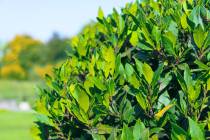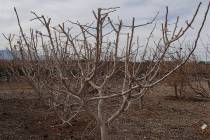Pomegranate fighting bug
Q: I have a pomegranate tree and for years it has been bearing fruit with dark red seeds. I have been fighting a bug on the tree and this year the fruit seed is pale white, almost gray. Can you give me some advice on this? Is it okay to eat?
A: Your color description of the seeds, or arils, are right on for immaturity. However, if the plant is "ill" you might get the same color response. Yes, they are safe to eat.
Is it possible it could be related to the bug problem? I am not sure about that, but I rather doubt it since I had one other report from someone who has the same problem and he reports no bug problems at all.
Try leaving the fruit on the tree longer (closer to Halloween) and check it then. The fruit can be left on the tree well into December and it will sweeten even more provided we do not get extreme freezing temperatures. If you here of a very cold freeze coming in, pick them. The fruit can handle a light freeze but not a hard one.
Q: Our pomegranate tree has been planted for five years. We've had some fruit the past two years.
Lots more this year. I just spotted one already split with critters on it. The leaves look shriveled. I gave it fruit tree fertilizer and an extra watering. Any other suggestions would really be appreciated.
A: I looked at the pictures you sent to me and your pomegranate does not seem to be very full, as well. The reasons the tree may not have filled out is because of shade or not enough light during the day, not getting enough water or not fertilizing at the beginning of the growing year.
Don't worry about the curled leaves. This can be fairly common on pomegranate.
They like to be deep-watered just like any other landscape tree or shrub or fruit tree. If you want good production, don't treat them like a cactus. So in short, fertilize the tree in late January or February and start weekly irrigations the first week of February.
I would construct the basin around the tree to be about 3 feet in diameter and 3 to 4 inches deep. Fill the basin each time you irrigate. They will perform well on drip-irrigation if they're getting enough water. Make sure you have at least four emitters and you run them long enough to deliver the water they need, deep enough. After a good watering, the soil should be wet down to 2 feet deep.
The critters you see are leaf-footed plant bugs and normally soap and water sprays would be enough to knock them back but, if you use it, apply it weekly to the undersides of the leaves and all over the foliage.
Pyrethrins sprays will also work on them. If you are hard-core, the insecticide Sevin will kill them but don't spray when the plant is in flower. Spray very early in the morning or at dusk when bees are not present.
Q: I wonder if I can grow hydrangeas in a climate similar to Tuscon, Ariz., if I arrange my drip-irrigation to be especially generous to the plant. Would that help compensate for the dry air?
Is there any particular cultivar that can better handle dry nonhumid weather?
A: When you are speaking of hydrangea I am thinking you mean the grandiflora type sometimes called PG's. Drip-irrigation of any type will not affect the humidity much. Surface mulches that help keep the soil moist and cool and reducing wind will affect humidity more.
There are several types of hydrangeas. All of them are going to require; protection from high-intensity sunlight in a climate similar to Tucson or Las Vegas particularly when it starts to get hot, massive amounts of soil improvement, organic surface mulches such as wood chips and moist soils that are kept relatively low in salts.
When we are talking about hydrangea selection, you are going to be better off with an oakleaf hydrangea rather than a grandiflora type. Oakleaf hydrangea is native to North America and can handle higher temperatures and less humidity than any of the others. It can also handle the cold. You can buy them online.
Pick a northern or Eastern exposure in the landscape. Filtered light from about 10 a.m. to noon followed by shade in the afternoons would be best.
Amend the soil with a good quality compost with at least 50 percent compost mixed into the backfill surrounding the roots. Do not let the roots dry out at any time.
Soak the soil surrounding the roots immediately after planting. Cover the surface of the soil with a minimum of 2 inches of wood chips that will decompose.
Your plant will not look perfect as it would in Eastern or Northern states. Expect the margins of the leaves to show some scorching because of the low humidity and high temperatures combined with the general nature of Southwestern soils.
Fertilize three to four times a year with an all-purpose fertilizer that is high in phosphorus. Rose fertilizers or fertilizers used for camellias or gardenias would be appropriate.
Keep the soil moist and do not let it dry out. Make sure the soil is moist just prior to high temperatures.
Q: Will Moringa grow in Las Vegas? What would be its care and maintenance? What is its freeze tolerance?
A: The short answer to your question is that the top of the plant will not survive our winters in Las Vegas. This means that if we are to grow it in our climate, even though it's woody, we must treat it like an herbaceous perennial in a way similar to Bougainvillea. Moringa, horseradish tree, some call it mulangay, is a tropical woody plant that has become popular due to health claims. This does not mean we cannot grow it in the Las Vegas Valley. It just means we have to put a lot more effort into growing it here.
Moringa can be started from seed or stem cuttings easily. Whether from seed or cuttings, start it as early in the season as possible in warm soils that have a lot of compost added to it.
Plant it in a location that is as warm during the winter as possible. Keep it out of the wind. As soon as you can plant it outside, push its growth with applications of nitrogen fertilizers, commercial or organic it's your choice, and keep the soil moist but drained well.
You are trying to establish it and growing as robustly as possible before the cool temperatures of the fall, October and November, set in. When the growth of this plant gets about 18 inches tall, cut it back to 12 inches in height.
Any time new growth gets 18 to 24 inches long, cut it back to 12 to 18 inches. This pruning will cause the tree to become shrubby and facilitate the harvesting of leaves and other plant parts.
This tree will want to grow one central trunk as rapidly as it can. You don't want that.
You want it to grow like a bush, not a tree. Cutting it back repeatedly as I described will cause it to "sucker" all along the trunk and side branches.
Give this plant an application of an all-purpose fertilizer high in nitrogen late in the fall before the leaves begin dropping and before freezing temperatures. This will put some nutrients, including nitrogen, inside the plant in reserve for next year's growth.
This technique is called late fall fertilization and works in many woody plants as long as you don't apply it too early or too late.
If we are lucky enough not to get any freezing temperatures during the winter, let it continue to grow next year and continue to cut back excessively long growth. But it is more likely to freeze back to the ground during our normal winter freezing temperatures.
You will want to protect as much of the crown of the shrub or tree as possible. The crown is where the trunk, or trunks, enter the soil. Pile a mound of wood chips around the crown of the plant as high as possible to insulate it from freezing temperatures. You might also throw a blanket around the crown when you hear it's going to freeze.
This is a big tree so trying to grow it in a container will not work very well.
— Bob Morris is a horticulture expert living in Las Vegas and professor emeritus for the University of Nevada. Visit his blog at xtremehorticulture.blogspot.com. Send questions to Extremehort@aol.com.




























